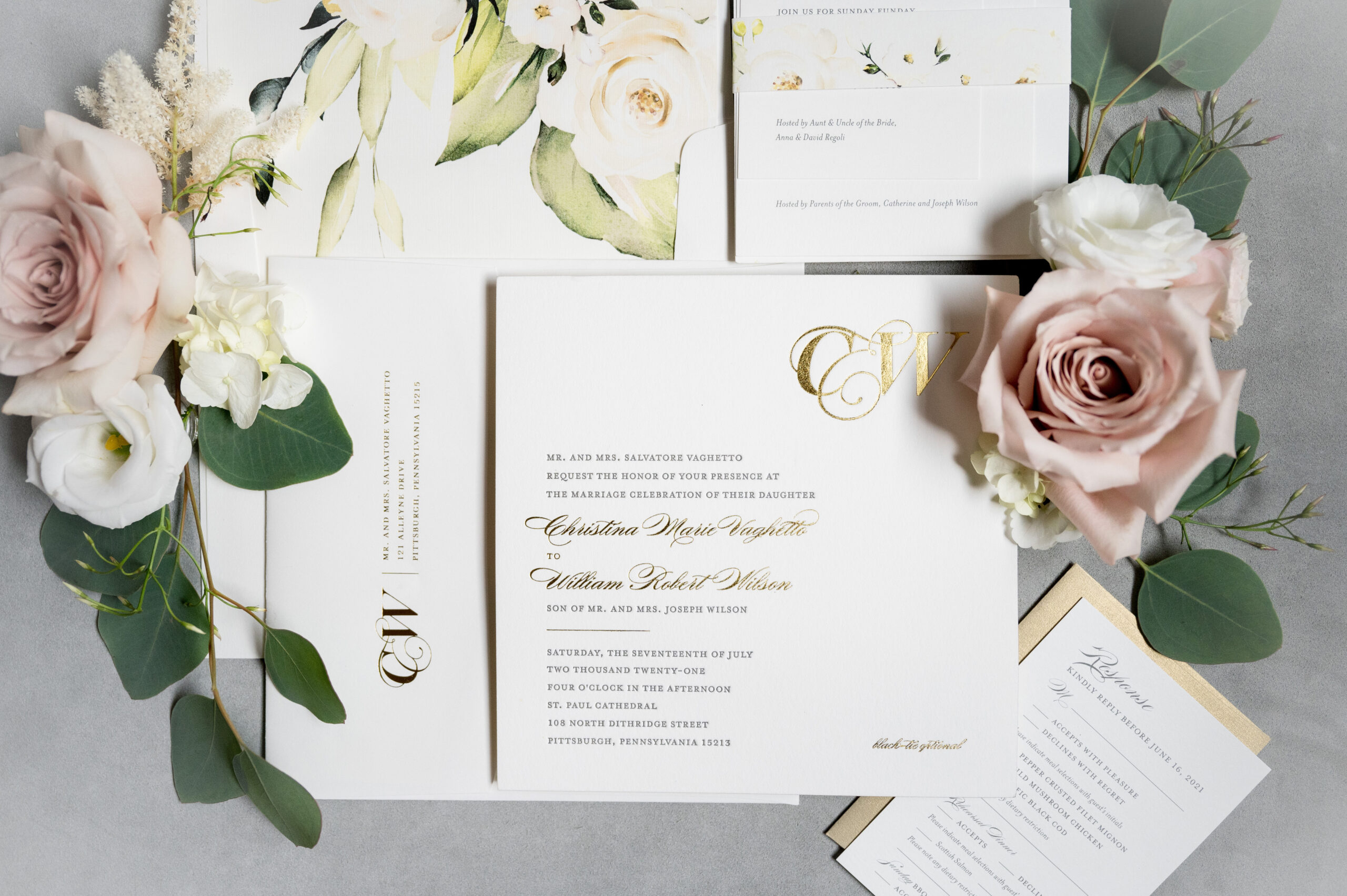Printing methods can dramatically impact both the look and investment for Wedding and Event Invitations and Stationery. Below are some brief descriptions and photos of some popular options and important considerations to keep in mind. When creating bespoke stationery, I often use multiple print and production methods for a unique and truly YOU suite.

Digital/Flat Printing
Digital printing offers crisp, full-color results. Perfect for designs with multiple colors or photographs, it’s the most popular option for creating beautiful invitations within budget constraints.
Also known as flat printing, it offers quick turnaround times and cost-effectiveness, especially for smaller quantities since no setup plates are required. Keep in mind that paper options are restricted to lighter colors, most often white and cream.
This versatile printing method works for just about anything and can be combined with other techniques.
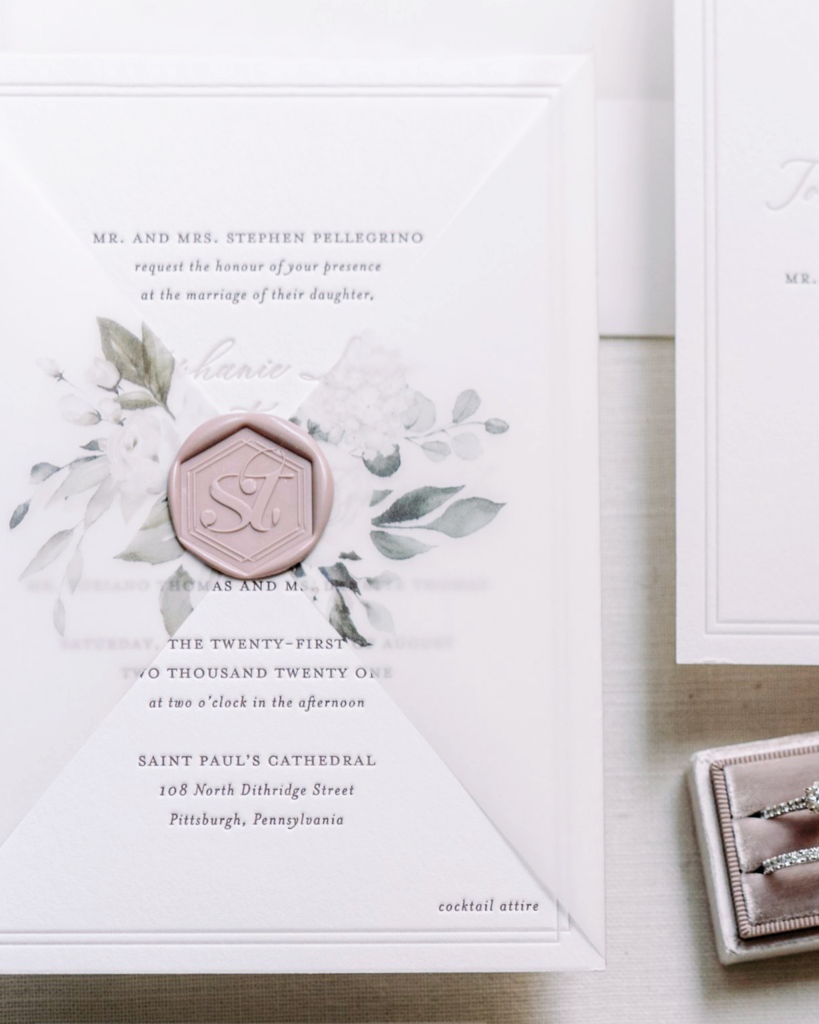
Letterpress
Letterpress printing is a stunning method where your design is made into a plate, secured to a press, and pressed into the paper with hand-mixed ink. Each piece is typically hand-fed, creating gorgeous, high-quality impressions that work beautifully for both formal and informal designs.
The tactile impressions you can feel make each piece special. However, you’ll need custom plates created, which adds to the initial setup costs, and the manual process means a longer timeline, which is well worth the wait.

Foil Stamping
Foil stamping brings a touch of shine to your stationery by using heated metal plates to press thin foil into paper instead of ink. You can choose between matte (subtly shiny) and metallic (mirror-like) finishes, and modern foil comes in a rainbow of colors beyond the traditional gold, silver, copper, and rose gold.
This technique creates stunning, eye-catching details that can transform your stationery. While it requires custom die creation, the results are worth considering for special elements of your design. It’s the most popular upgrade for invitations.
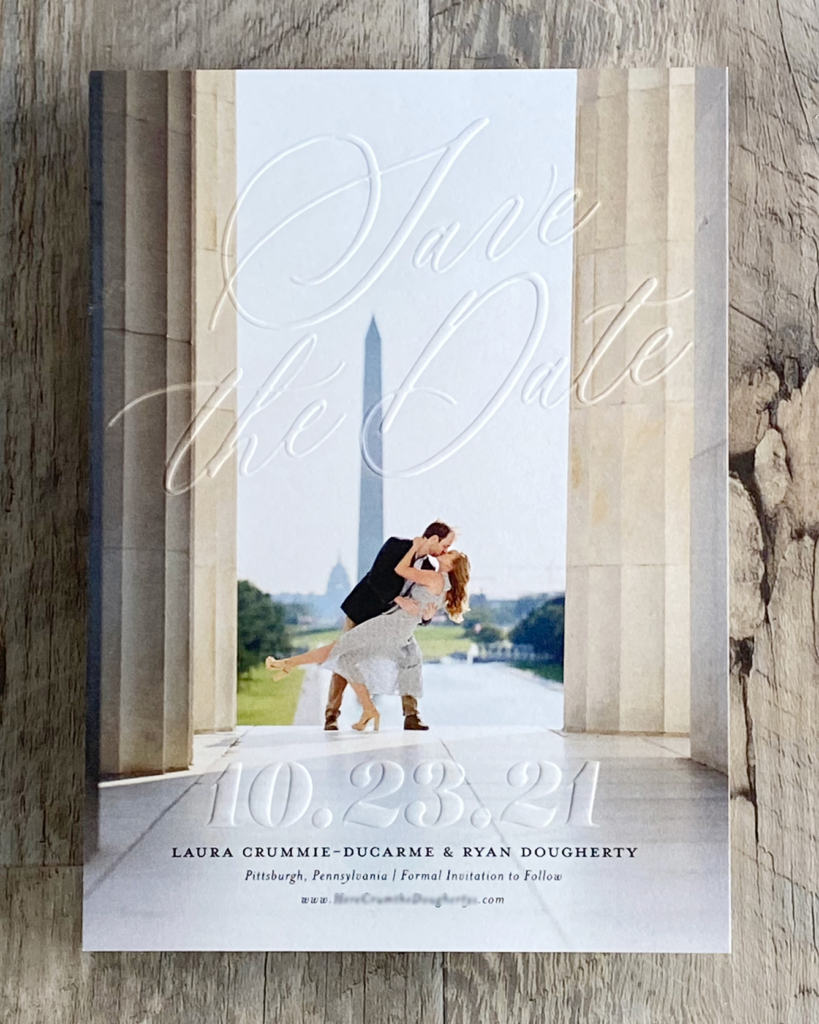
Emboss/Deboss
These techniques add sophisticated dimension to your pieces by creating raised (emboss) or recessed (deboss) designs without ink. The effect is subtle and elegant, working beautifully on thick papers to create texture without color. Setup costs include creating custom dies, and simpler designs tend to work best with this method.
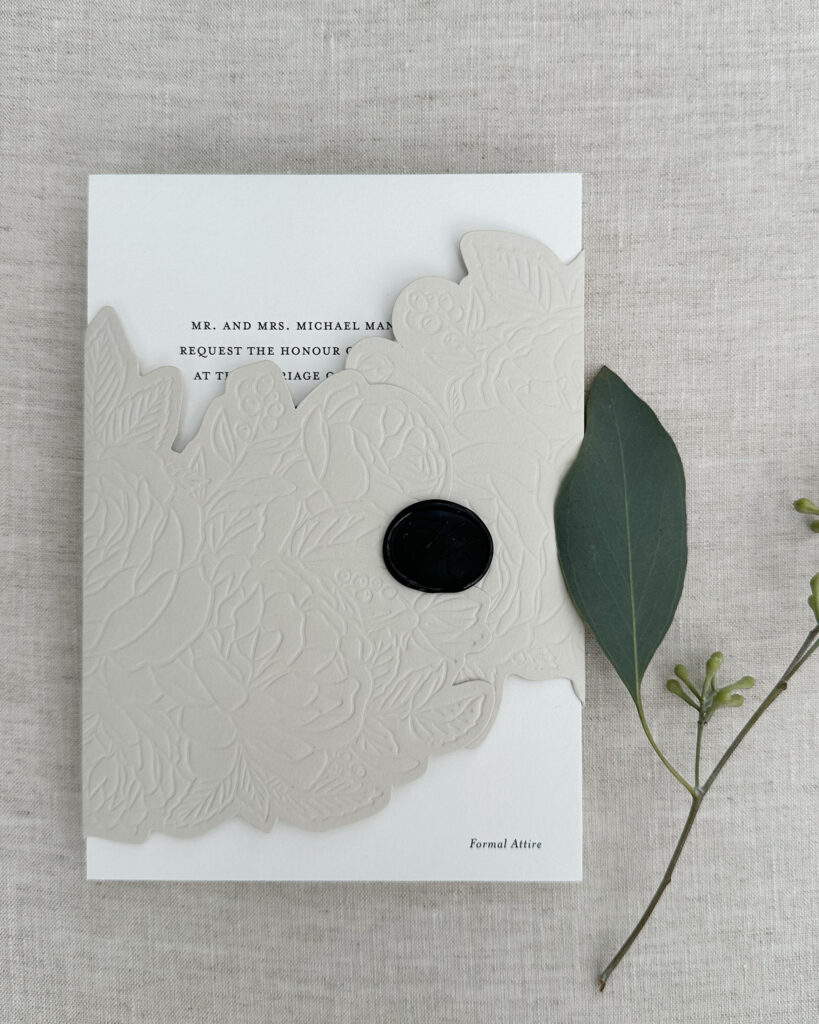
Die Cutting
Die cutting uses custom metal dies to create specific shapes and patterns in your paper. It’s different from laser cutting because it uses physical dies. This technique adds dimension and visual interest, and it combines well with other printing methods. While it requires custom die creation, it’s more cost-effective for larger quantities. Simpler designs help keep costs manageable.
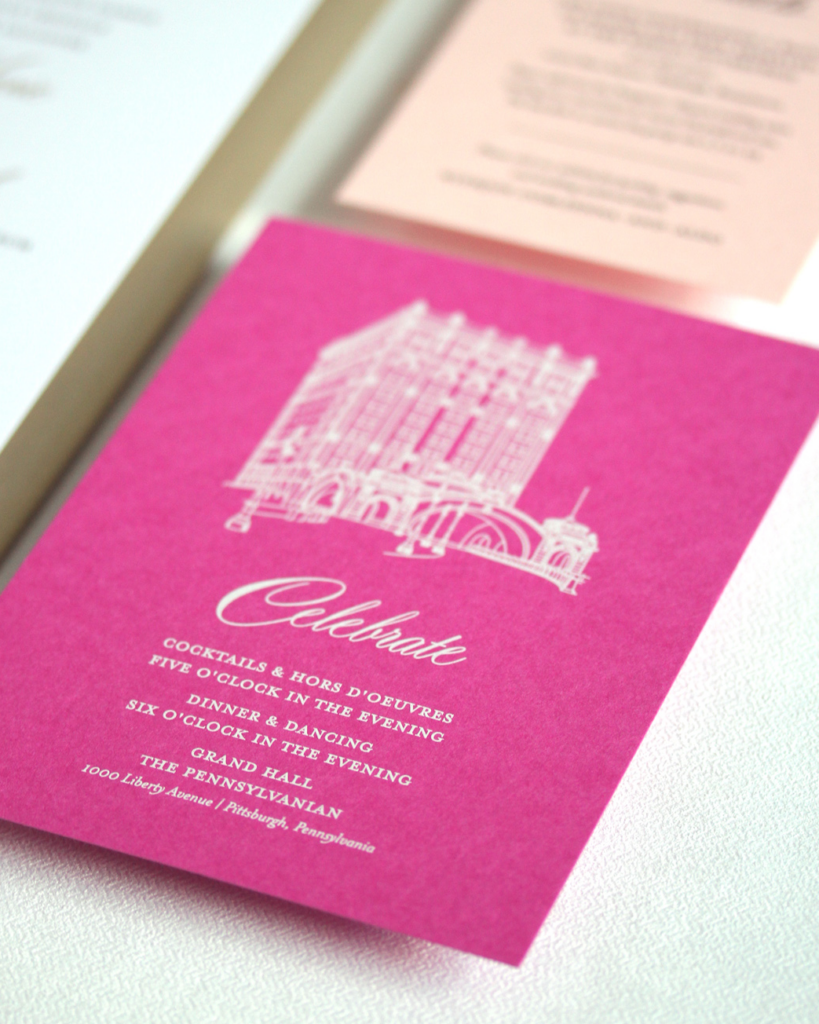
Digital White Ink
White ink printing is a special form of digital printing that allows for white designs on dark or colored papers – something traditional digital printing can’t achieve. White text and designs that pop against dark or colorful papers.
This technique works beautifully for modern designs and adds an unexpected twist to traditional stationery. While more expensive than standard digital printing, it’s still more budget-friendly than methods like foil or letterpress.
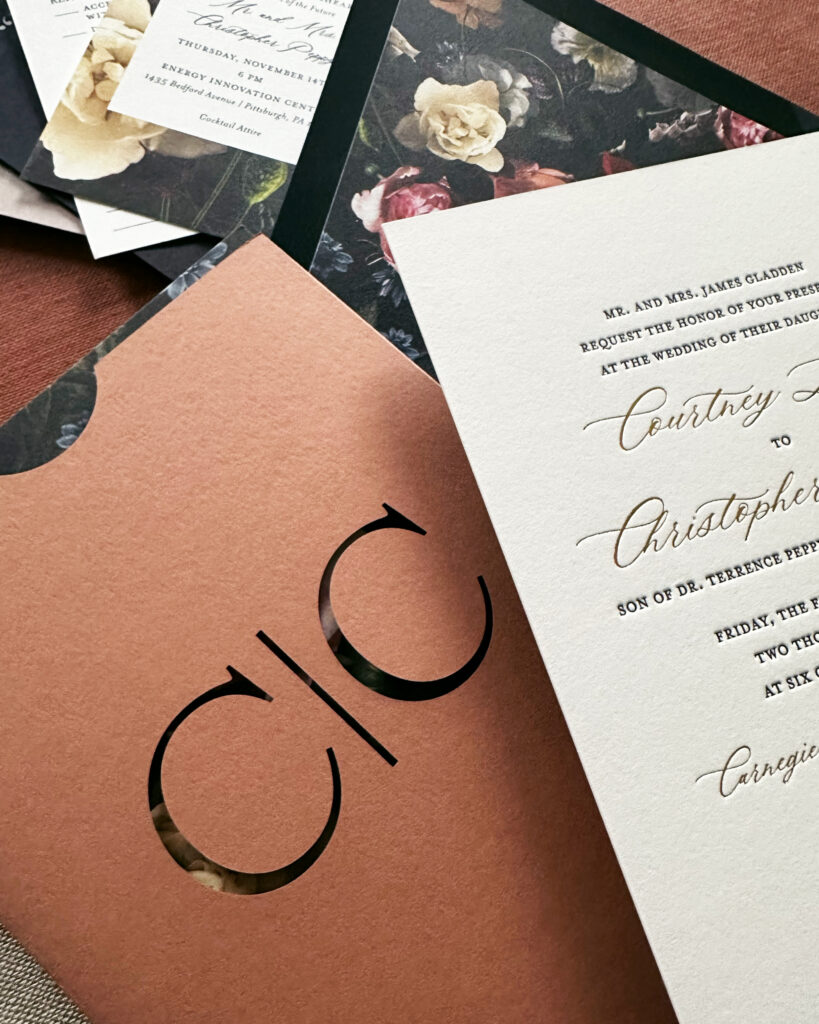
Laser Cutting
Laser cutting offers precision for intricate patterns using computerized cutting. Unlike die cutting, each piece is individually cut without physical dies. The results are incredibly detailed with a modern, sophisticated look. There are no die costs to worry about, making it perfect for both small and large quantities. Pricing varies based on design complexity and cutting time.
Creating Your Dream Suite (Within Budget)
When selecting what printing methods to use for your suite, we’ll talk through the quantity needed, timeline, and budget priorities.
Many of my clients combine multiple techniques for maximum impact. For instance, you might pair digital printing with foil accents, or letterpress with die-cut details.
Click the link below to fill out an inquiry form to get your custom quote!

Printing methods can dramatically impact both the look and investment for Wedding and Event Invitations and Stationery. Below are some brief descriptions and photos of some popular options and important considerations to keep in mind. When creating bespoke stationery, I often use multiple print and production methods for a unique and truly YOU suite.

Digital/Flat Printing
Digital printing offers crisp, full-color results. Perfect for designs with multiple colors or photographs, it’s the most popular option for creating beautiful invitations within budget constraints.
Also known as flat printing, it offers quick turnaround times and cost-effectiveness, especially for smaller quantities since no setup plates are required. Keep in mind that paper options are restricted to lighter colors, most often white and cream.
This versatile printing method works for just about anything and can be combined with other techniques.

Letterpress
Letterpress printing is a stunning method where your design is made into a plate, secured to a press, and pressed into the paper with hand-mixed ink. Each piece is typically hand-fed, creating gorgeous, high-quality impressions that work beautifully for both formal and informal designs.
The tactile impressions you can feel make each piece special. However, you’ll need custom plates created, which adds to the initial setup costs, and the manual process means a longer timeline, which is well worth the wait.

Foil Stamping
Foil stamping brings a touch of shine to your stationery by using heated metal plates to press thin foil into paper instead of ink. You can choose between matte (subtly shiny) and metallic (mirror-like) finishes, and modern foil comes in a rainbow of colors beyond the traditional gold, silver, copper, and rose gold.
This technique creates stunning, eye-catching details that can transform your stationery. While it requires custom die creation, the results are worth considering for special elements of your design. It’s the most popular upgrade for invitations.

Emboss/Deboss
These techniques add sophisticated dimension to your pieces by creating raised (emboss) or recessed (deboss) designs without ink. The effect is subtle and elegant, working beautifully on thick papers to create texture without color. Setup costs include creating custom dies, and simpler designs tend to work best with this method.

Die Cutting
Die cutting uses custom metal dies to create specific shapes and patterns in your paper. It’s different from laser cutting because it uses physical dies. This technique adds dimension and visual interest, and it combines well with other printing methods. While it requires custom die creation, it’s more cost-effective for larger quantities. Simpler designs help keep costs manageable.

Digital White Ink
White ink printing is a special form of digital printing that allows for white designs on dark or colored papers – something traditional digital printing can’t achieve. White text and designs that pop against dark or colorful papers.
This technique works beautifully for modern designs and adds an unexpected twist to traditional stationery. While more expensive than standard digital printing, it’s still more budget-friendly than methods like foil or letterpress.

Laser Cutting
Laser cutting offers precision for intricate patterns using computerized cutting. Unlike die cutting, each piece is individually cut without physical dies. The results are incredibly detailed with a modern, sophisticated look. There are no die costs to worry about, making it perfect for both small and large quantities. Pricing varies based on design complexity and cutting time.
Creating Your Dream Suite (Within Budget)
When selecting what printing methods to use for your suite, we’ll talk through the quantity needed, timeline, and budget priorities.
Many of my clients combine multiple techniques for maximum impact. For instance, you might pair digital printing with foil accents, or letterpress with die-cut details.
Click the link below to fill out an inquiry form to get your custom quote!

I am committed to maintaining an inclusive business that cultivates a positive experience for all backgrounds no matter their race, religion, or orientation. It is important to me that you know that you are safe working with me and I am here to support your journey in love or your business ventures, equally and without discrimination. I believe in cultivating inclusion and supporting the diversity of all people, relationships, cultural backgrounds, and spiritual practices. All are welcome here and I am ready to learn and listen where necessary. This is a safe and positive space for all.
